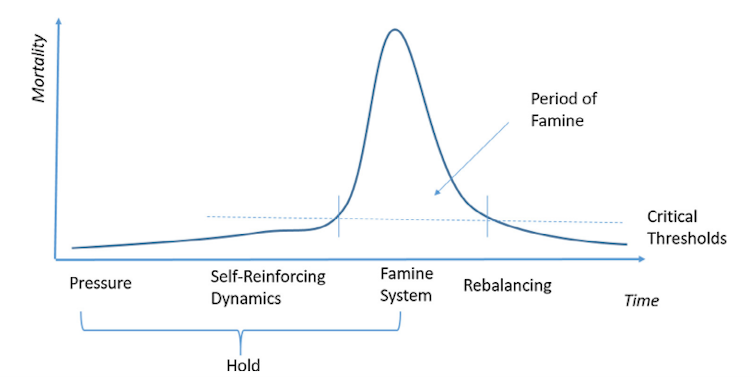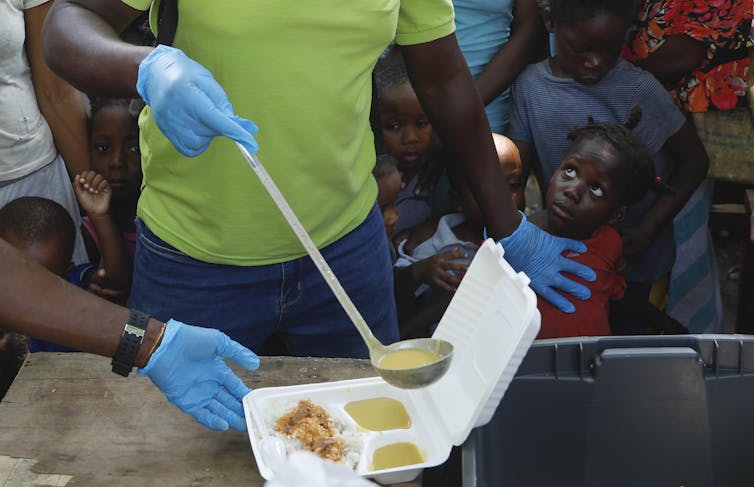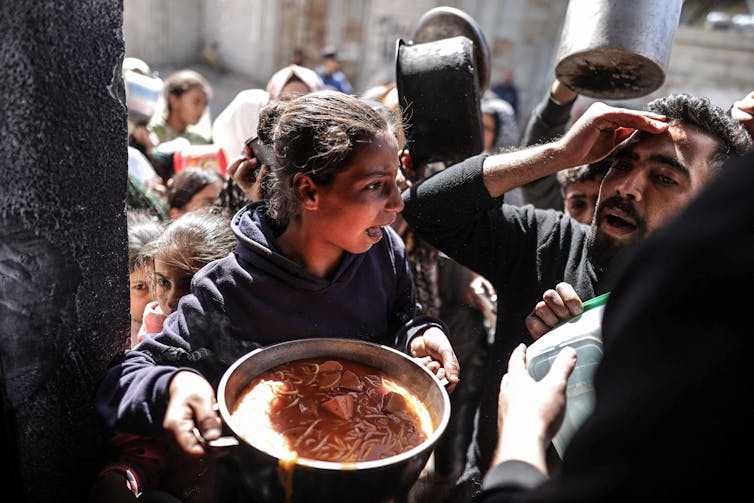The United Nations’ latest report on hunger makes for grim reading. On April 24, 2024, the international body released its annual Global Report on Food Crises, showing that 281.6 million people faced acute hunger in 2023.
And indications for 2024 suggest worse may be to come. In March, the United Nations’ highest technical body for assessing food and nutrition crises warned of an “imminent famine” in Gaza. The U.N. also raised the alarm about situations in Sudan, Haiti and other countries around the world.
To those of us who study global hunger issues, the situations in Gaza, Sudan, Haiti and a host of other countries reflect a growing trend in which severe crises – often, but not only, related to conflict – have the potential to become famines.
But how and under what conditions do famines form?
Recent academic thinking suggests that famines can be viewed as complex systems. As a scholar who researches hunger and humanitarian relief efforts, I wanted to see if it was possible to identify a consistent underlying pattern in the way these systems formed.
So in 2018 I developed a famine systems model that identifies five elements that describe the evolution of these crises. First, they require severe pressure on a population that is then kept in place by a “hold” that prevents the release of this pressure. This then creates self-reinforcing dynamics that can tip over into a famine system – which is when a “famine” is often officially declared – involving rapid increases in malnutrition and mortality. Finally, there is a rebalancing.
A representation of the famine systems model

To better understand how the model works, it is worth examining each of its stages:
1. Intensifying pressure
Pressure in a famine cycle results from a combination of disruptive factors and vulnerability. Disruptive factors are things that affect the ability of a population to obtain the food it needs from normal sources. For example, in the Somalia famine of 2011-2012, a combination of successive droughts and a rise in global food prices made it difficult for communities to grow or buy food and maintain their livestock.
Vulnerability refers to the susceptibility of a population – or parts of that population – to experiencing these crises based on the resources and options available to them, and their food and nutrition status. In the case of Somalia, certain clans with limited support networks to reach out to for help were particularly at risk.
If there are strong and comprehensive disruptive factors and high vulnerability, the pressure can be severe.

2. Persistent holds
A hold is a condition that prevents the affected population from receiving release from famine pressure. Natural holds occur after a drought, when the rhythms of the agricultural cycle mean that the next harvest will not arrive for another year. Economic holds could relate to an extended period of elevated global food prices. Political holds can involve ongoing conflict or policies that make an area inaccessible.
When these holds prevent assistance from getting in to alleviate famine pressures – or prevent populations from leaving – they are highly impermeable. This frequently happens in sieges, such as Germany’s encirclement of Leningrad during World War II.
During the siege of Sarajevo in the 1990s, however, the hold was more permeable, and some assistance and trade reached the populations, helping to prevent famine.
3. Self-reinforcing dynamics
If severe pressure is kept in place by a hold, it generates self-reinforcing dynamics, such as rapid rises in local food prices, declines in wages and asset prices and a resulting deterioration of terms of trade. This makes it even more difficult for affected people to obtain sufficient nutrients.
The dynamics can also lead to a breakdown in social norms. Populations may resort to stealing or rioting. Where possible, populations often migrate in search of better conditions or assistance. Combinations of these dynamics have been observed across historical contexts, from the biblical siege of Samaria to the Great Irish Famine of the late 1840s to the more recent crisis in Somalia.

4. Emerging famine systems
If the self-reinforcing dynamics are not stopped, at a certain point the ability of a population to stave off the crisis will be exhausted, and the situation will tip over into a famine system. A key feature of this model is the recognition that these interacting parts of the system often work together to generate a relatively sudden rise in malnutrition and deaths.
Although not always the case, a “classic” pattern for famine systems – whether in Somalia during 2011-2012 or Leningrad in 1941-1942 – is a steep rise and high peak in mortality. This is the period in which a famine can be unambiguously declared, but it is also too late to prevent the loss of life.
Rebalancing
Finally, there is a rebalancing of the system – often signaled by a decline in mortality. This may take place for two principal reasons. The first is that the famine system has already affected the most vulnerable people – such as children and the elderly or socially marginalized groups – and therefore cannot sustain the high levels of mortality. The second is when the key holds are removed and the self-reinforcing dynamics are counteracted by, for example, a new bumper harvest or the provision of scaled-up humanitarian assistance.
How Gaza fits the model
In terms of the crises currently facing the world, I’m deeply worried when I see elements of this model coming together in multiple places.
For instance, the severe pressure in northern Gaza stems from the disruptive factor of the conflict affecting a vulnerable population with few livelihood options. The hold consists of the constrained access to food due to both insufficient humanitarian relief and the breakdown of local markets. The self-reinforcing dynamics include price rises and social unrest, especially at food delivery points. And the rapid increase in malnutrition may signal the emergence of a famine system in the north of the territory.
The model also suggests, however, that famines are not inevitable. Providing release from holds can allow urgent assistance to counter the pressure, ease self-reinforcing dynamics, and save lives and alleviate suffering by preventing famine systems from forming.

